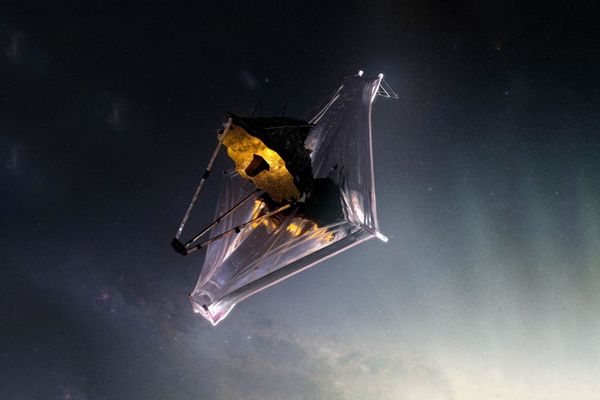
The location of galaxies across our universe don't randomly exist. Instead, they are connected by a threadlike arrangement with massive barren "oceans" of dark matter in between them. Known as the "cosmic web," a term that was coined in 1996 by the University of Toronto's Richard Bond, it provides the building blocks for infrastructure of the universe. Think of it like a blueprint for all of existence.
While astronomers know that the cosmic web exists, how it evolved into what it is today largely remains a mystery. However, using NASA's James Webb Space Telescope (JWST), a team of astronomers have now discovered a peculiar string of 10 threaded galaxies in the early universe that existed 830 million years after the Big Bang.
"This is one of the earliest filamentary structures that people have ever found associated with a distant quasar," said Feige Wang, an assistant research professor at the University of Arizona Steward Observatory and lead author of one of the two papers published in The Astrophysical Journal Letters detailing the discovery.
JWST has given astronomers the opportunity to peer back in time and observe the very faint, dim objects that existed shortly after the Big Bang. As Fang noted, this early string of galaxies is anchored by a luminous quasar. A quasar is an active galactic nucleus that is believed to be energized by a supermassive black hole. Astronomers have observed thousands of quasars at far away distances from our galaxy. But this is the first time astronomers have observed the early formation of the cosmic web in a formation that's fastened by a quasar.
"I was surprised by how long and how narrow this filament is," said one of the authors, Xiaohui Fan, in a statement. "I expected to find something, but I didn't expect such a long, distinctly thin structure."
This observation adds on to piling research around the cosmic web. Earlier this year, scientists found the first evidence of shockwaves rippling through the cosmic web. The team of astronomers believe that the invisible string of galaxies recently observed by JWST will evolve into a massive cluster of galaxies, like the well-known Coma Cluster.
The astronomers believe these "unprecedented observations" will not only provide important insights into the early universe by better understanding a young string of the cosmic web, but also how black holes "assembled."
"The last two decades of cosmology research have given us a robust understanding of how the cosmic web forms and evolves," said team member Joseph Hennawi of the University of California, Santa Barbara. "ASPIRE (A SPectroscopic survey of biased halos In the Reionization Era) aims to understand how to incorporate the emergence of the earliest massive black holes into our current story of the formation of cosmic structure."
The findings are part of a bigger mission for JWST to study the early universe— which includes understanding the underpinnings of the earliest galaxies, and the birth of black holes. There are at least eight quasars at the center of JWST's ASPIRE project that formed less than one billion years after the Big Bang. Since quasars are powered by supermassive black holes, questions remain about what fuels their rapid growth.

The astronomers believe these "unprecedented observations" will not only provide important insights into the early universe by better understanding a young string of the cosmic web, but also how black holes "assembled."
"We have learned that these black holes are situated in massive young galaxies that provide the reservoir of fuel for their growth," said Jinyi Yang of the University of Arizona, who is leading the study of black holes with ASPIRE. Yang elaborated that strong winds produced by black holes can "suppress the formation of stars in the host galaxy."
"Such winds have been observed in the nearby universe but have never been directly observed in the Epoch of Reionization," Yang said, referring to the time period of one billion years that existed after the Big Bang. "The scale of the wind is related to the structure of the quasar. In the Webb observations, we are seeing that such winds existed in the early universe."







